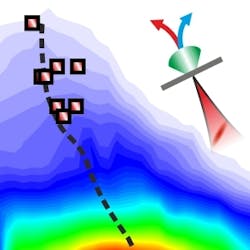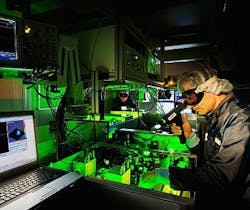Promising for cancer therapy, terawatt laser enables higher energies for particle acceleration
Physicists at the Helmholtz-Zentrum Dresden-Rossendorf (HZDR; Dresden, Germany) directed light from the Dresden Laser Acceleration Source (DRACO) perpendicularly and obliquely onto a thin metal foil, allowing them to demonstrate for the first time that accelerated protons follow the direction of the laser light, which could be promising for cancer therapy. By incorporating this new data into a conventional model describing the laser particle acceleration, high proton energies that have not been realized so far might become achievable.
A light pulse coming from the DRACO laser and directed perpendicular onto a thin metal foil accelerates electrons and protons perpendicularly to the foilâs surface, just like previous models predict. But that is not the case with a tilted laser pulse. If the angle of the thin light disk is slightly tilted with respect to the axis of propagation, something unexpected happens during the first phase of the particle acceleration. The electrons feel the rotation of the light disk and follow the direction in which the light hits the foil. Moreover, protons are accelerated along this direction as well and, in contrast to the electrons, maintain their direction. This novel observation of the directional dependence permitted the physicists to also look directly at the underlying acceleration process.
âDuring the first acceleration phase, the distance between the electrons and the foil is extremely small. Once the short laser pulse has pushed them through the foil, they immediately swing back again because the foil has a positive charge. That is one reason why we were very surprised to discover that not only the electrons follow the motion of the laser light, but also the protons exhibit this previously unknown directional dependence,â notes Karl Zeil, doctoral candidate and main author of the work. He managed to detect another particular feature that only occurs with ultrashort laser pulses: The initial phase is decisive for the entire acceleration process. During the first 30 fs, the acceleration is very efficient; the short and efficient acceleration phase is followed by a longer expansion phase, during which a uniform and symmetrical plasma cloud is formed. The protons, however, gain so much energy during the first phase which, in turn, makes them so fast that they finally can reach higher energies than conventional models would predict.
Precisely how the fast electrons oscillate around the foil, and thus, accelerate the protons, is investigated by the HZDR scientists also with the help of simulations. Karl Zeil: âExperiments and simulations agree quite well with each other. With the newly obtained data we can now extend the presently existing models. This essentially means that ultra-short pulsed lasers like our DRACO laser could potentially be capable of generating protons with sufficiently high energy so that they can be used in future cancer therapy. That we were successful in obtaining these results is both very pleasing and very motivating.â
The DRACO laser currently reaches a peak power of 150 TW, albeit only for a period of 30 fs at a time. The HZDR physicists want to expand DRACO to 500 TW and are currently building a petawatt laser system called PENELOPE. As a modern accelerator technology, particle acceleration with laser light provides considerable advantages when compared to conventional systems: The acceleration distance is much shorter and the costs for such systems are potentially lower. Currently, the OncoRay center, which is jointly supported by cooperation partners HZDR, University Hospital, and TU Dresden, is building a modern proton therapy facility on the University Hospitalâs campus, which will be used for cancer research and therapy. For the first time ever, the prototype of a high-performance laser will be operated here in addition to a conventional proton accelerator.
The results of the work have been published in Nature Communications; for more information, please visit http://www.nature.com/ncomms/journal/v3/n6/full/ncomms1883.html.
-----
Follow us on Twitter, 'like' us on Facebook, and join our group on LinkedIn
Follow Laser Focus World on your iPhone or Android
Subscribe now to BioOptics World magazine; it's free!

